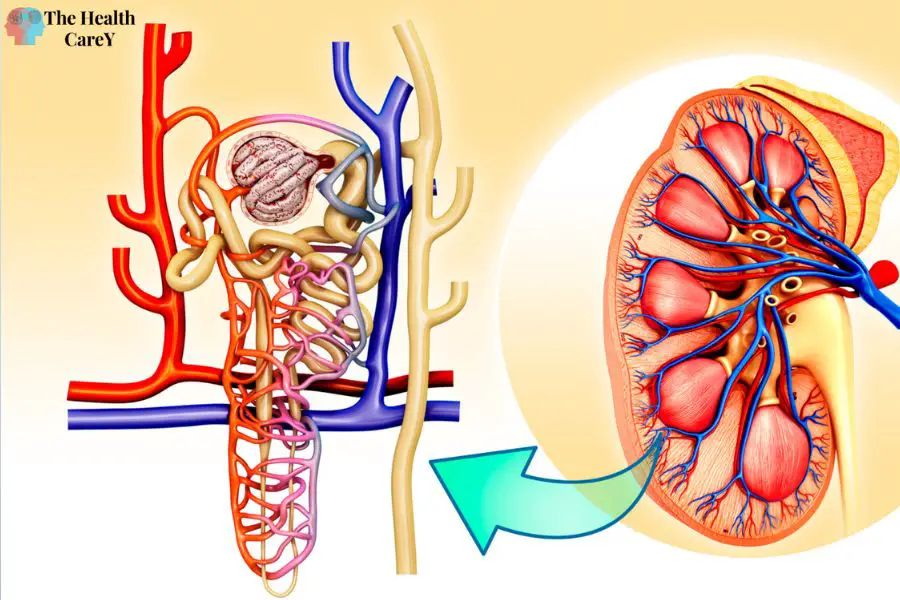You may suffer kidney scarring if you have been experiencing symptoms such as blood in your urine, frequent urination, or swelling in your legs and ankles. Kidney scarring, also known as fibrosis, is a condition in which the kidneys become damaged and scarred, leading to various symptoms and complications.
The kidneys are vital in filtering waste and excess fluids from your blood, so any damage to these organs can have serious consequences. Various factors, including diabetes, high blood pressure, autoimmune diseases, chronic infections, and long-term use of certain medications, can cause kidney scarring. Men are more likely than women to develop kidney scarring, and the condition is more common in older adults.
What is Kidney Scarring?
Kidney or renal cortical scarring refers to scar tissue formation in the kidneys. This scar tissue can affect the normal functioning of the kidneys and can lead to complications such as chronic kidney disease, high blood pressure, and kidney failure.
Scarring in the kidneys can occur due to various reasons such as infections, high blood pressure, glomerulosclerosis, trauma, drug-induced injury, blockage of the ureter, blockage of the blood vessel, and chemical injury. In some cases, you can be born with this abnormality.
Symptoms of kidney scarring may not be present in the early stages. The prominent identifier of this condition is proteinuria protein in the urine. Usually detected during routine examinations, it may lead to abdominal fluid retention, swollen eyes, or generalized edema.
Kidney scarring can lead to potentially serious complications such as kidney failure, high blood pressure, and chronic kidney disease if left untreated. Therefore, it is important to seek medical attention if you experience any symptoms or have any risk factors for kidney scarring.
Kidney scarring treatment depends on the condition’s underlying cause and severity. Medications may sometimes be prescribed to manage symptoms and prevent further kidney damage. In severe cases, surgery may be required to remove the scar tissue or repair kidney damage.
In conclusion, kidney scarring is a serious condition that can affect the normal functioning of the kidneys and lead to complications if left untreated. It is important to seek medical attention if you experience any symptoms or have any risk factors for kidney scarring. Treatment depends on the underlying cause and severity of the condition.
Causes of Kidney Scarring
Kidney scarring, or renal fibrosis, occurs when scar tissue replaces healthy kidney tissue. This can lead to kidney damage and impaired function. Several factors can contribute to the development of kidney scarring.
High Blood Pressure
High blood pressure, or hypertension, is a leading cause of kidney disease and can contribute to the development of kidney scarring. When blood pressure is consistently high, it can damage the blood vessels in the kidneys and lead to scarring.
Diabetes
Diabetes is another common cause of kidney scarring. High glucose levels in the blood can damage the small blood vessels in the kidneys, leading to scarring and impaired function.
Infections
Infections, particularly those that affect the urinary tract, can also contribute to the development of kidney scarring. Chronic or recurrent infections can lead to inflammation and scarring of the kidneys.
Inflammation
Chronic inflammation can also contribute to the development of kidney scarring. Conditions like lupus and sickle cell disease can cause kidney inflammation, leading to scarring and impaired function.
Genetic Factors
Genetic factors can also play a role in the development of kidney scarring. Certain genetic mutations can make individuals more susceptible to kidney disease and scarring.
Other Causes
Other factors that can contribute to the development of kidney scarring include exposure to toxins, certain medications, and autoimmune diseases.
It is important to note that kidney scarring may not always have a clear cause and may develop over time without any obvious symptoms. Regular check-ups with a healthcare provider can help identify kidney scarring early on and prevent further damage.
Symptoms and Signs of Kidney Scarring
Kidney scarring, or renal scarring, can cause various symptoms and signs. These may include:
- Swelling: Kidney scarring can cause fluid buildup, leading to swelling in different body parts, such as the legs, ankles, and feet.
- Pain: Kidney scarring can cause pain in the lower back, sides, or abdomen. The pain may be dull or sharp and can vary in intensity.
- Headaches: Kidney scarring can cause headaches that are often severe and persistent.
- Weight gain: Kidney scarring can lead to weight gain due to fluid buildup in the body.
- High blood pressure: Kidney scarring can cause high blood pressure, further damaging the kidneys and other organs.
If you experience any of these symptoms or signs, seeing a doctor for an evaluation is important. Kidney scarring can be diagnosed through various tests, including blood tests, urine tests, and imaging tests such as ultrasound or CT scan.
Treatment for kidney scarring depends on the underlying cause and severity of the scarring. In some cases, the scarring may not require treatment and can be managed through lifestyle changes such as a healthy diet and exercise. Medications or surgery may be necessary in other cases to treat the scarring and prevent further kidney damage.
It is important to prevent kidney scarring by managing underlying conditions such as high blood pressure and diabetes, avoiding medications that can damage the kidneys, and staying hydrated.
Diagnosis Techniques of Kidney Scarring
If you are experiencing symptoms of kidney scarring, your doctor may use several diagnostic techniques to determine the extent and severity of the condition. Here are some of the most common methods:
Biopsy
A kidney biopsy involves removing a small sample of kidney tissue for examination under a microscope. This can help doctors determine the cause of kidney scarring and assess the extent of kidney damage. A needle is inserted through the skin and kidney during the biopsy to collect the tissue sample. This procedure is usually done under local anesthesia and takes about 30 minutes.
Ultrasound
Ultrasound imaging uses high-frequency sound waves to create images of the kidneys. This non-invasive technique can help doctors identify abnormalities in the kidneys’ size, shape, or structure, which may indicate kidney scarring. During the procedure, a small device called a transducer is placed on the skin over the kidneys, and sound waves are transmitted through the body to create images on a computer screen.
MRI
Magnetic resonance imaging (MRI) uses a strong magnetic field and radio waves to create detailed images of the inside of the body. This imaging technique can help doctors identify any kidney abnormalities, including scarring. MRI is a non-invasive procedure that does not involve radiation but can be more expensive than other imaging techniques.
Blood Tests
Blood tests can help doctors assess kidney function and identify underlying conditions causing kidney scarring. These tests can measure the creatinine level in the blood, a waste product normally filtered out of the body by the kidneys. A high level of creatinine in the blood may indicate reduced kidney function.
In conclusion, if you are experiencing symptoms of kidney scarring, your doctor may use a combination of these diagnostic techniques to determine the cause and extent of the condition. These methods can help doctors develop an effective treatment plan to manage your symptoms and prevent further kidney damage.

Complications and Effects of Kidney Scarring
Kidney scarring can lead to several complications and effects that can affect your overall health. Here are some of the possible complications and effects that you should be aware of:
- Chronic kidney disease (CKD): Kidney scarring can lead to the development of CKD, which is a long-term condition that can cause permanent damage to your kidneys. CKD can lead to complications, including high blood pressure, anemia, bone disease, and nerve damage.
- Kidney failure: In severe cases, kidney scarring can lead to kidney failure, where your kidneys stop functioning properly. This can lead to a buildup of waste products and fluids in your body, which can be life-threatening if left untreated.
- Proteinuria: Kidney scarring can cause proteinuria, which is a condition where your urine contains an excessive amount of protein. This can indicate kidney damage and lead to further complications if left untreated.
- High blood pressure: Kidney scarring can cause high blood pressure, damaging your blood vessels and increasing your risk of heart disease and stroke.
- Edema: Kidney scarring can lead to fluid buildup in your body, which can cause swelling in your legs, feet, and ankles.
- Nephrotic syndrome: Kidney scarring can cause nephrotic syndrome, where your kidneys leak large amounts of protein into your urine. This can lead to swelling, weight gain, and other complications.
- Idiopathic: In some cases, the cause of kidney scarring is unknown, referred to as idiopathic kidney scarring. This can make it difficult to treat the condition and may require ongoing monitoring and management.
It is important to seek medical attention if you experience any symptoms of kidney scarring or any of the above complications or effects. Your doctor can help you manage your condition and prevent further kidney damage.
Treatment and Management
If you have kidney scarring, your treatment plan will depend on the underlying cause of your condition. Your doctor may recommend one or more of the following treatment options:
Medications
Your doctor may prescribe medications to help manage your kidney scarring. These may include:
- ACE inhibitors: These medications help to relax your blood vessels and reduce your blood pressure.
- Diuretics: These medications help to remove excess fluid from your body, which can help to reduce swelling and lower your blood pressure.
- Angiotensin receptor blockers (ARBs): These medications work similarly to ACE inhibitors, helping to relax your blood vessels and reduce your blood pressure.
- Steroids: These medications can help to reduce inflammation in your kidneys, which can help to slow down the progression of kidney scarring.
- Statins: These medications can help to lower your cholesterol levels, which can help to reduce your risk of developing heart disease.
- Anticoagulants: These medications can help to prevent blood clots from forming in your kidneys, which can help to reduce your risk of developing further kidney damage.
Dialysis
If your kidney function has become severely impaired, your doctor may recommend dialysis. Dialysis is a medical treatment involving a machine to remove waste products and excess fluid from your blood. There are two main types of dialysis: hemodialysis and peritoneal dialysis.
Kidney Transplant
In some cases, your doctor may recommend a kidney transplant. This involves surgically replacing your damaged kidney with a healthy kidney from a donor. Kidney transplants are usually only recommended for people with severe kidney damage who are not responding to other treatment options.
Following your doctor’s instructions closely and attending all follow-up appointments to monitor your condition is important. Proper treatment and management can help slow the progression of kidney scarring and maintain kidney function.
Prevention and Lifestyle Changes
If you have been diagnosed with kidney scarring or want to prevent it, there are several lifestyle changes that you can make to reduce your risk. Taking care of your overall health and making simple changes to your habits can help prevent further kidney damage.
Healthy Eating
One of the most important things you can do is to eat a healthy, balanced diet. This means eating plenty of fruits, vegetables, lean protein, and whole grains. Avoid processed foods, sugary drinks, and foods high in sodium. A dietitian can help you create a kidney-friendly meal plan that meets your nutritional needs.
Exercise
Regular exercise is essential for maintaining a healthy weight and reducing your risk of developing kidney scarring. Most days of the week, aim for at least 30 minutes of moderate exercise, such as brisk walking, cycling, or swimming. Talk to your healthcare provider before starting any new exercise program.
Managing Blood Pressure
High blood pressure can damage your blood vessels, including those in your kidneys, and increase your risk of developing kidney scarring. Take steps to manage your blood pressure, such as taking medication as prescribed, reducing sodium intake, and maintaining a healthy weight.
Avoiding Smoking and Alcohol
Smoking and alcohol can damage your blood vessels and reduce the amount of oxygen reaching your kidneys. Quitting smoking and limiting your alcohol intake can help protect your kidneys and reduce your risk of developing kidney scarring.
Managing Fluid Retention
If you have kidney scarring, you may be at risk of fluid retention. This can cause swelling in your legs, ankles, and feet. To manage fluid retention, limit sodium intake, elevate your legs when sitting, and wear compression stockings.
Strengthening Your Immune System
Some types of kidney scarring can be caused by autoimmune diseases, which occur when your immune system attacks your body. To help prevent this, strengthen your immune system, such as getting enough sleep, managing stress, and eating a healthy diet.
Making these lifestyle changes and working closely with your healthcare provider can help prevent kidney scarring and improve overall health.
Conclusion
Kidney scarring is a serious condition that can lead to irreversible damage to your organs. Various illnesses, such as glomerulonephritis, urinary tract infections, and focal segmental glomerulosclerosis (FSGS), can trigger this condition.
When kidney scarring occurs, the tiny blood vessels in your kidneys, called glomeruli, become damaged and scarred. This can lead to a loss of kidney function, as your kidneys can no longer filter waste products and excess fluids from your blood.
If you are experiencing symptoms such as blood in your urine, swelling in your legs or feet, or high blood pressure, it is important to see a doctor as soon as possible. Your doctor can perform tests to determine if you have kidney scarring and recommend a treatment plan.
Treatment for kidney scarring may include medication to control high blood pressure or reduce protein loss, as well as lifestyle changes such as eating a healthy diet and exercising regularly. In some cases, kidney transplantation may be necessary to restore kidney function.
It is important to take care of your kidneys and seek medical attention if you are experiencing any symptoms of kidney disease. The American Society of Nephrology recommends that you get regular check-ups with your doctor to monitor your kidney function and detect any problems early on. You can manage kidney scarring and maintain your overall health and well-being with proper care and treatment.
Frequently Asked Questions
What are the long-term consequences of renal scarring?
Renal scarring can lead to chronic kidney disease, eventually resulting in kidney failure. This can cause various symptoms, including fatigue, nausea, and swelling in the legs and feet. Kidney failure can be life-threatening and may require dialysis or a kidney transplant.
What medications can cause scarring of the kidneys?
Certain medications, such as nonsteroidal anti-inflammatory drugs (NSAIDs), can cause kidney damage and scarring if taken in high doses or for long periods. Other medications that can cause kidney damage include antibiotics, blood pressure medications, and chemotherapy drugs.
Is kidney scarring a serious condition?
Kidney scarring is a serious condition that can lead to long-term kidney damage and kidney failure. It is important to seek medical attention if you experience symptoms of kidney scarring, such as blood in the urine or swelling in the legs and feet.
What are the symptoms of renal cortical scarring?
Symptoms of renal cortical scarring may include blood in the urine, swelling in the legs and feet, and high blood pressure. In some cases, there may be no symptoms at all.
What causes cortical scarring of the kidneys in adults?
Cortical scarring of the kidneys in adults can be caused by various factors, including diabetes, high blood pressure, autoimmune diseases, and chronic infections. Sometimes, it may be caused by a genetic predisposition to kidney disease.
How common is kidney scarring?
Kidney scarring is relatively common, particularly among people with diabetes, high blood pressure, and other chronic health conditions. It is estimated that up to 30% of people with diabetes will develop kidney disease, which can lead to kidney scarring over time.
Also Read:





















